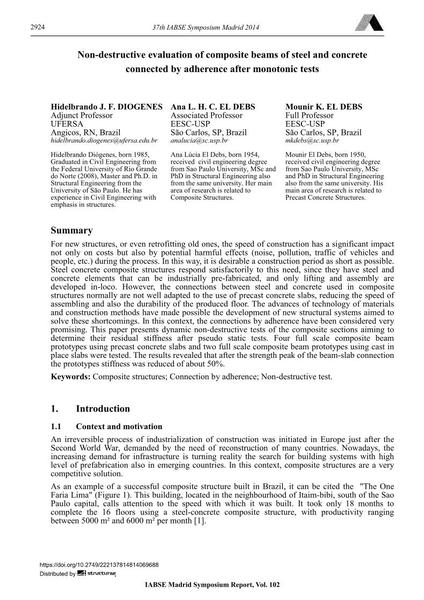Non-destructive evaluation of composite beams of steel and concrete connected by adherence after monotonic tests

|
|
|||||||||||
Détails bibliographiques
| Auteur(s): |
Hidelbrando J. F. Diógenes
Ana L. H. C. El Debs Mounir K. El Debs |
||||
|---|---|---|---|---|---|
| Médium: | papier de conférence | ||||
| Langue(s): | anglais | ||||
| Conférence: | IABSE Symposium: Engineering for Progress, Nature and People, Madrid, Spain, 3-5 September 2014 | ||||
| Publié dans: | IABSE Symposium Madrid 2014 | ||||
|
|||||
| Page(s): | 2924-2931 | ||||
| Nombre total de pages (du PDF): | 8 | ||||
| Année: | 2014 | ||||
| DOI: | 10.2749/222137814814069688 | ||||
| Abstrait: |
For new structures, or even retrofitting old ones, the speed of construction has a significant impact not only on costs but also by potential harmful effects (noise, pollution, traffic of vehicles and people, etc.) during the process. In this way, it is desirable a construction period as short as possible. Steel concrete composite structures respond satisfactorily to this need, since they have steel and concrete elements that can be industrially pre-fabricated, and only lifting and assembly are developed in-loco. However, the connections between steel and concrete used in composite structures normally are not well adapted to the use of precast concrete slabs, reducing the speed of assembling and also the durability of the produced floor. The advances of technology of materials and construction methods have made possible the development of new structural systems aimed to solve these shortcomings. In this context, the connections by adherence have been considered very promising. This paper presents dynamic non-destructive tests of the composite sections aiming to determine their residual stiffness after pseudo static tests. Four full scale composite beam prototypes using precast concrete slabs and two full scale composite beam prototypes using cast in place slabs were tested. The results revealed that after the strength peak of the beam-slab connection the prototypes stiffness was reduced of about 50%. |
||||
| Mots-clé: |
Structures composites
|
||||
